Add this eBook to your basket to receive access to all 122 records. Our indexes include entries for the spelling symington. In the period you have requested, we have the following 122 records (displaying 81 to 90): These sample scans are from the original record. You will get scans of the full pages or articles where the surname you searched for has been found. Your web browser may prevent the sample windows from opening; in this case please change your browser settings to allow pop-up windows from this site. Musicians
(1905)
The calendar of the Trinity College of Music, London, for 1905-1906 includes a section listing current licentiates and associates in music of the college. Some are specified as singers, pianists, violinists, &c., but most of the listing is for music in general. | Sample scan, click to enlarge

| Boys entering Loretto School
(1907)
The Reverend Dr Thomas Langhorne, who came to Musselburgh in Midlothian as an Episcopalian Church clergyman, established a small school for boarders and day scholars at Loretto House, so called because the grounds contained the ruins of the mediaeval chapel of St Mary of Loretto. To celebrate the centenary of the school in 1925, a second edition of the school register was published, edited by A. H. Buchanan-Dunlop. Relatively little was known of many of the earliest scholars, but from 1835 onwards the register generally gives full name, in capitals, surname first; date of birth; period of time at Loretto; a brief biography; date of death; whether brother of any other boy in the register; and a sequential number. | Sample scan, click to enlarge
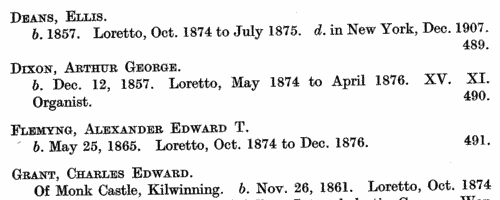
| Civil Servants and Office Holders
(1907)
The Imperial Calendar gives lists of officials and office-holders throughout England, Wales, Scotland and Ireland
| Sample scan, click to enlarge
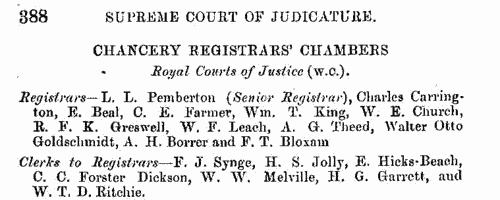
| Boys entering Loretto School
(1910)
The Reverend Dr Thomas Langhorne, who came to Musselburgh in Midlothian as an Episcopalian Church clergyman, established a small school for boarders and day scholars at Loretto House, so called because the grounds contained the ruins of the mediaeval chapel of St Mary of Loretto. To celebrate the centenary of the school in 1925, a second edition of the school register was published, edited by A. H. Buchanan-Dunlop. Relatively little was known of many of the earliest scholars, but from 1835 onwards the register generally gives full name, in capitals, surname first; date of birth; period of time at Loretto; a brief biography; date of death; whether brother of any other boy in the register; and a sequential number. | Sample scan, click to enlarge
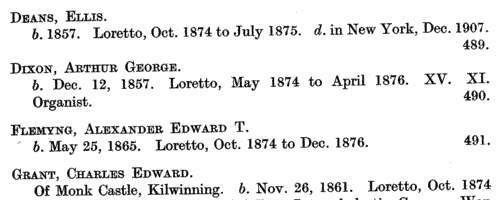
| Civil Servants and Office Holders
(1910)
The Imperial Calendar gives lists of officials and office-holders throughout England, Wales, Scotland and Ireland
| Sample scan, click to enlarge
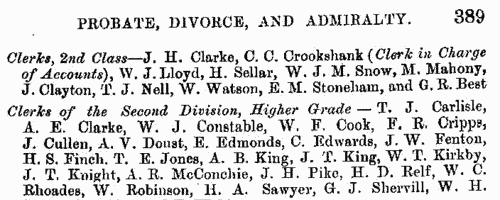
| Boys entering Wellington College in Berkshire
(1913)
Wellington College, near Wokingham, was originally founded for the education of sons of military officers. A register of boys entering the school from First Term 1859 to Michaelmas 1933 was compiled by F. G. Lawrence for the Old Wellingtonian Society. In each entry the boy's name is given in full, in bold, surname first; age at entry (usually 11 to 14); then, in brackets, the name of the dormitory or house to which he belonged, in italics, with the years of his stay; then his father's name (usually surname and initials, but not christian name) with military decorations where appropriate. School prefects and captains are noted as such; if the boy played cricket for the school, XI with the years; academic honours, scholarships, &c.; a brief biography; and date of death, or (where known) address in 1933. Year of marriage is given, and sometimes the wife's name and/or her father's name. Clearly, those boys who kept contact with the school and/or had distinguished military careers have detailed entries; others disappeared into oblivion on leaving. | Sample scan, click to enlarge
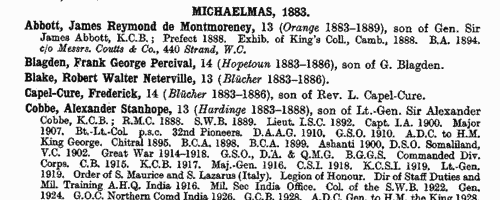
| Boys entering Haileybury College, Hertfordshire
(1918)
Haileybury College, near Hertford, was founded by the East India Company in 1806, and incorporated by Royal Charter in 1864. This register of pupils entering the school from 1862 to 1931 was edited by a master there, Laurence Arthur Speakman. The boys are listed by term of joining the school, and then alphabetically by name (in bold), surname first (in capitals). There is then usually a precise birthdate, and the name and address of his father; his period at the school, starting with abbreviations to indicate the house to which he belonged (B., Batten; B. F., Bartle Frere; C., Colvin; E., Edmonstone; Ha., Hailey; Hi., Highfield; L., Lawrence; Le B., Le Bas; M., Melvill; Th., Thomason; T., Trevelyan), and the first and last forms attended (e. g., IV., fourth form). Where a member of a school team there is then an indication (e. g., XI., cricket). For some pupils, with whom the school had lost touch, Speakman was only able to record the details of their time at Haileybury; but for most a brief career synopsis is then given, and current address (as in 1931) or date of death.
| Sample scan, click to enlarge
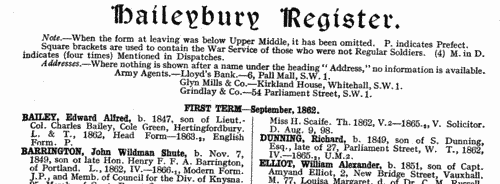
| Chemists and Druggists
(1919)
The official register printed under the direction of the Pharmaceutical Society of Great Britain pursuant to the act of 31 & 32 Victoriae, cap. 121 (An Act to Regulate the Sale of Poisons, and Alter and Amend the Pharmacy Act, 1852) comprised two sections:
1.The Register of Pharmaceutical Chemists, giving date of registration, number of examination certificate, full name (surname first, in capitals), and residence;
2. The Register of Chemists and Druggists, giving date of registration, full name (surname first, in capitals), residence, number of examination certificate (major or minor), and qualification. | Sample scan, click to enlarge

| Boiler Makers and Iron and Steel Shipbuilders: Glasgow (1921)
The monthly report of the United Society of Boiler Makers and Iron and Steel Shipbuilders contains, as well as internal union business, reports of meetings; obituaries; warnings about named individuals falling into arrears, or becoming 'out of benefit'; members 'run out'; subscription sales; new members admitted; second class transferred to first class membership; apprentices admitted; apprentices transferred to adult membership; and 'unapproved' apprentices. Members are normally identified by surname and initial, with membership number as appropriate. These abbreviations also occur: 1st, first class; 2nd, second class; 3rd, third class; A.I.S., angle iron smith; App., apprentice; A.W., acetylene worker; C., caulker; D., driller; H-up, holder-up; P., plater; R., riveter; S.I.W., sheet iron worker. January 1921
| Sample scan, click to enlarge
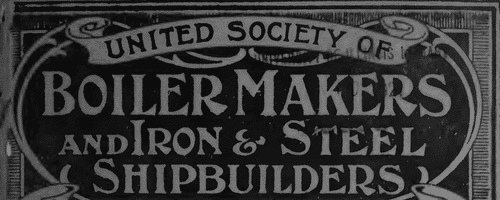
| Boiler Makers and Iron and Steel Shipbuilders: Motherwell (1921)
The monthly report of the United Society of Boiler Makers and Iron and Steel Shipbuilders contains, as well as internal union business, reports of meetings; obituaries; warnings about named individuals falling into arrears, or becoming 'out of benefit'; members 'run out'; subscription sales; new members admitted; second class transferred to first class membership; apprentices admitted; apprentices transferred to adult membership; and 'unapproved' apprentices. Members are normally identified by surname and initial, with membership number as appropriate. These abbreviations also occur: 1st, first class; 2nd, second class; 3rd, third class; A.I.S., angle iron smith; App., apprentice; A.W., acetylene worker; C., caulker; D., driller; H-up, holder-up; P., plater; R., riveter; S.I.W., sheet iron worker. January 1921
| Sample scan, click to enlarge
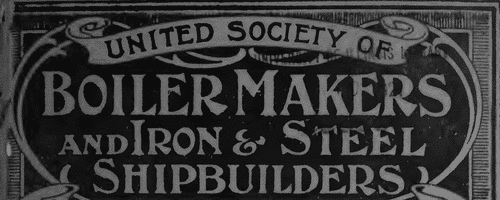
|
Research your ancestry, family history, genealogy and one-name study by direct access to original records and archives indexed by surname.
|











